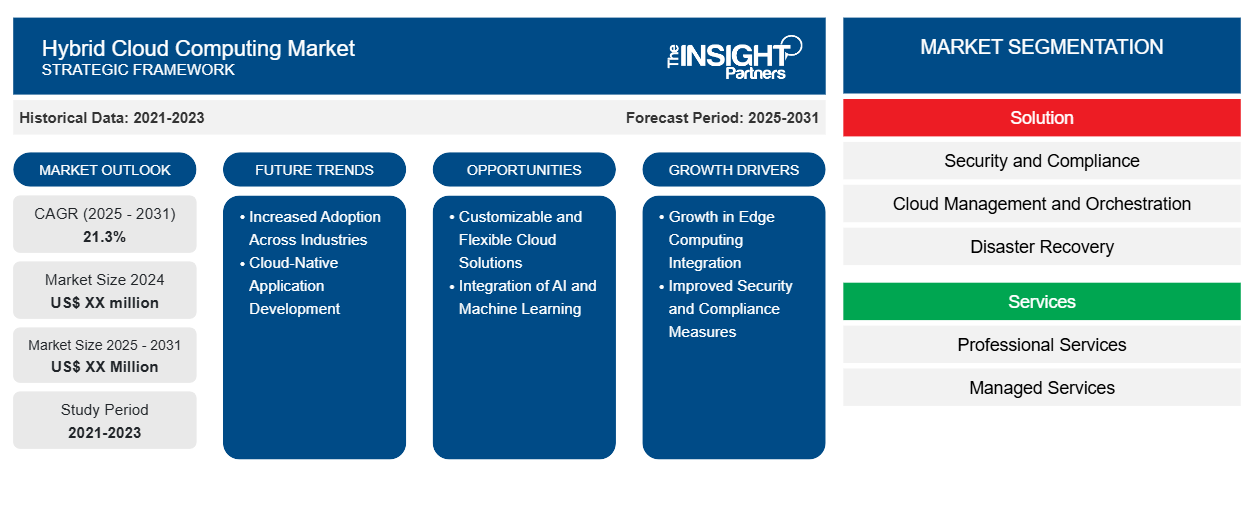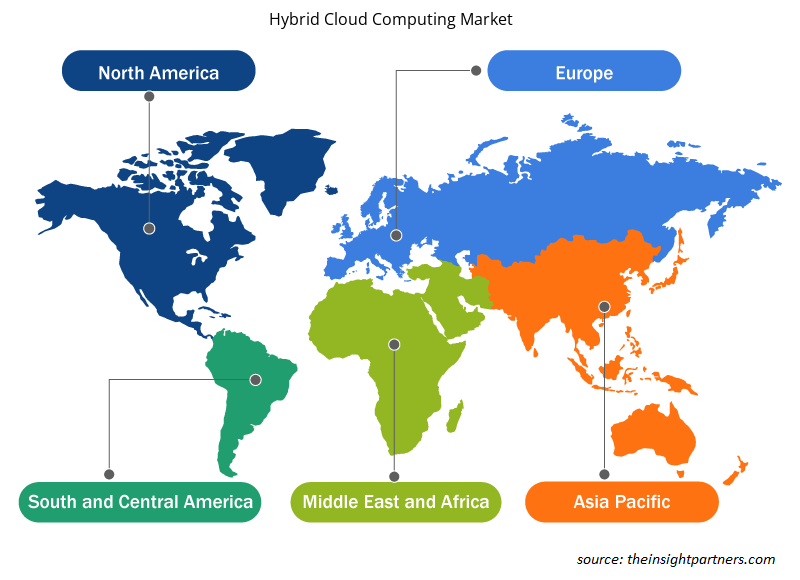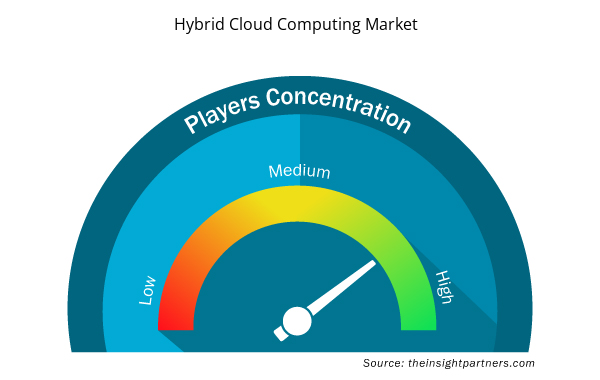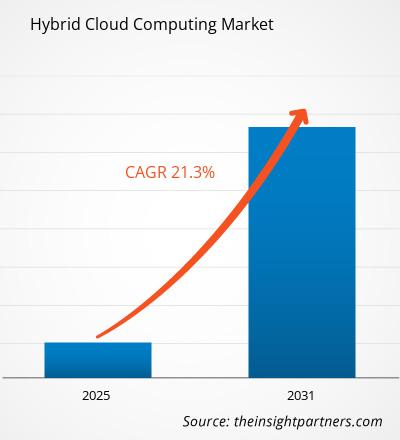من المتوقع أن يسجل سوق الحوسبة السحابية الهجينة معدل نمو سنوي مركب بنسبة 21.3٪ من عام 2025 إلى عام 2031، مع توسع حجم السوق من XX مليون دولار أمريكي في عام 2024 إلى XX مليون دولار أمريكي بحلول عام 2031.
يُقسّم التقرير حسب الحلول (الأمن والامتثال، إدارة السحابة وتنظيمها، التعافي من الكوارث، الاستضافة الهجينة)؛ الخدمات (الخدمات المهنية، الخدمات المُدارة)؛ نموذج الخدمة (المنصة كخدمة (PaaS)، البرمجيات كخدمة (SaaS)، البنية التحتية كخدمة (IaaS))؛ حجم المؤسسة (الشركات الكبيرة، الشركات الصغيرة والمتوسطة)؛ المستخدم النهائي (السلع الاستهلاكية وتجارة التجزئة، الإعلام والترفيه، الطاقة والمرافق، الرعاية الصحية وعلوم الحياة، التصنيع، الخدمات المصرفية والمالية والتأمينية، تكنولوجيا المعلومات والاتصالات، وغيرها). ويُفصّل التحليل العالمي بشكل أكبر على المستوى الإقليمي والدول الرئيسية. ويُقدّم التقرير القيمة بالدولار الأمريكي للتحليل والقطاعات المذكورة أعلاه.
غرض التقرير
يهدف تقرير "سوق الحوسبة السحابية الهجينة" الصادر عن "ذا إنسايت بارتنرز" إلى وصف المشهد الحالي والنمو المستقبلي، وأهم العوامل المحفزة، والتحديات، والفرص المتاحة. وسيوفر هذا التقرير رؤى ثاقبة لمختلف أصحاب المصلحة في قطاع الأعمال، مثل:
- مزودي التكنولوجيا/المصنعين: لفهم ديناميكيات السوق المتطورة ومعرفة فرص النمو المحتملة، وتمكينهم من اتخاذ قرارات استراتيجية مستنيرة.
- المستثمرون: إجراء تحليل شامل للاتجاهات فيما يتعلق بمعدل نمو السوق، والتوقعات المالية للسوق، والفرص المتاحة عبر سلسلة القيمة.
- الهيئات التنظيمية: لتنظيم السياسات ومراقبة الأنشطة في السوق بهدف تقليل الانتهاكات والحفاظ على ثقة المستثمرين ودعم سلامة السوق واستقرارها.
تجزئة سوق الحوسبة السحابية الهجينة
حل
- الأمن والامتثال
- إدارة السحابة وتنظيمها
- التعافي من الكوارث
- الاستضافة الهجينة
خدمات
- الخدمات المهنية
- الخدمات المُدارة
نموذج الخدمة
- المنصة كخدمة
- البرمجيات كخدمة
- البنية التحتية كخدمة
حجم المنظمة
- الشركات الكبيرة
- الشركات الصغيرة والمتوسطة الحجم
المستخدم النهائي
- السلع الاستهلاكية والتجزئة
- الإعلام والترفيه
- الطاقة والمرافق
- الرعاية الصحية وعلوم الحياة
- تصنيع
- الخدمات المصرفية والمالية والتأمين
- تكنولوجيا المعلومات والاتصالات
قم بتخصيص هذا التقرير ليناسب متطلباتك
ستحصل على تخصيص لأي تقرير - مجانًا - بما في ذلك أجزاء من هذا التقرير، أو تحليل على مستوى الدولة، وحزمة بيانات Excel، بالإضافة إلى الاستفادة من العروض والخصومات الرائعة للشركات الناشئة والجامعات
سوق الحوسبة السحابية الهجينة: رؤى استراتيجية

- احصل على أهم اتجاهات السوق الرئيسية لهذا التقرير.ستتضمن هذه العينة المجانية تحليل البيانات، بدءًا من اتجاهات السوق وحتى التقديرات والتوقعات.
عوامل نمو سوق الحوسبة السحابية الهجينة
- نمو في تكامل الحوسبة الطرفية: من المتوقع أن يشهد تكامل الحوسبة الطرفية مع أنظمة السحابة الهجينة زيادةً ملحوظة. تُقرّب الحوسبة الطرفية معالجة البيانات من نقطة الطلب، مما يُحسّن أوقات الاستجابة ويُقلّل من استخدام النطاق الترددي. في بيئة السحابة الهجينة، يعني هذا أن الشركات قادرة على معالجة البيانات الأساسية على الحافة في الوقت الفعلي، مع استخدام السحابة لعمليات أقل حساسية للوقت. يُعدّ هذا التكامل مفيدًا بشكل خاص في مجالات مثل التصنيع والمركبات ذاتية القيادة، حيث تُعد معالجة البيانات في الوقت الفعلي أمرًا بالغ الأهمية. يتيح الجمع بين الحوسبة الطرفية والحوسبة السحابية الهجينة للشركات الاستفادة من قوة الحوسبة السحابية مع الحفاظ على سرعة وكفاءة معالجة الحافة.
- تحسين إجراءات الأمن والامتثال: تحسينات في أمن وامتثال بيئات السحابة الهجينة. مع تزايد تطور هذه الأنظمة، تبرز الحاجة إلى حلول أمنية شاملة تغطي السحابات العامة والخاصة. ستصبح تقنيات التشفير المُحسّنة، وأنظمة التعريف والتحكم في الوصول المتطورة، وتقنيات الكشف عن التهديدات المتقدمة هي القاعدة.
اتجاهات مستقبل سوق الحوسبة السحابية الهجينة
- تزايد الاعتماد على السحابة الهجينة في مختلف القطاعات: تتبنى العديد من القطاعات، بما في ذلك المصارف والتمويل، والرعاية الصحية، وتجارة التجزئة، والتصنيع، وحتى القطاع الحكومي، استراتيجيات السحابة الهجينة بشكل متزايد. ويعود هذا التوجه إلى الرغبة في زيادة المرونة والسرعة، وتحسين إدارة التكاليف، وتعزيز الأمن والامتثال. ففي قطاع الرعاية الصحية، على سبيل المثال، تُمكّن السحابة الهجينة من دمج أنظمة متنوعة، وتُسهّل مشاركة بيانات المرضى، وتدعم مشاريع الطب عن بُعد. كما تُسهم في إدارة المخاطر، وتحسين تجربة العملاء، وتعزيز الابتكار في القطاع المصرفي. أما في قطاع التجزئة، فتُمكّن السحابة الهجينة من تطبيق استراتيجية متعددة القنوات، وتُخصّص تجارب العملاء، وتُحسّن كفاءة سلسلة التوريد.
- تطوير تطبيقات سحابية أصلية: تُسهم بيئات السحابة الهجينة في نمو تطوير التطبيقات السحابية الأصلية. تستخدم الشركات الحاويات والخدمات المصغرة لبناء تطبيقات قابلة للتطوير وقابلة للنقل، تعمل عبر السحابات الخاصة والعامة. يُعزز هذا التوجه المرونة، ويُسرّع النشر، ويدعم الابتكار في تطوير التطبيقات.
فرص سوق الحوسبة السحابية الهجينة
- حلول سحابية مرنة وقابلة للتخصيص: مع تحسّن بيئات السحابة الهجينة، من المرجح أن يشهد عام 2024 زيادة في حلول السحابة الأكثر مرونة وقابلية للتكوين، والمصممة خصيصًا لتلبية متطلبات الأعمال الفردية. سيوفر مزودو الخدمات بدائل متنوعة تُمكّن المؤسسات من دمج الخدمات من السحابات العامة والخاصة، مما ينتج عنه بيئات سحابية مصممة خصيصًا. ستمتد هذه المرونة لتشمل مجالات مثل الأمان والأداء والامتثال، مما يسمح للمؤسسات بتخصيص بنيتها السحابية لتلبية احتياجاتها بدقة. ستستفيد الشركات في المناطق المحدودة أو ذات متطلبات التشغيل المختلفة بشكل كبير من هذه المرونة، حيث ستتيح لها الاستفادة من إمكانات الحوسبة السحابية دون المساس بمتطلباتها الخاصة.
- دمج الذكاء الاصطناعي والتعلم الآلي: يُعد دمج الذكاء الاصطناعي والتعلم الآلي في البنى التحتية السحابية الهجينة توجهًا متناميًا بسرعة. ومن أهم مكونات هذا التكامل إمكانية توظيف الذكاء الاصطناعي لتحسين إدارة الموارد في السحابة الهجينة. إذ تستطيع خوارزميات الذكاء الاصطناعي تحديد أنماط استخدام البيانات وأداء التطبيقات، مما يُمكّن من تخصيص الموارد بكفاءة أكبر عبر أنظمة السحابة العامة والخاصة. علاوة على ذلك، يُمكّن الذكاء الاصطناعي والتعلم الآلي من تحسين إدارة البيانات والتحليلات. تُسهّل الخدمات السحابية الوصول إلى الذكاء الاصطناعي والتعلم الآلي للشركات بمختلف أحجامها. ومن خلال دمج هذه التقنيات، يُمكن للشركات اكتساب رؤى ثاقبة من كميات هائلة من البيانات المُخزّنة في مختلف إعدادات السحابة.
رؤى إقليمية حول سوق الحوسبة السحابية الهجينة
قام محللو إنسايت بارتنرز بشرح شامل للاتجاهات والعوامل الإقليمية المؤثرة في سوق الحوسبة السحابية الهجينة خلال فترة التوقعات. ويناقش هذا القسم أيضًا قطاعات سوق الحوسبة السحابية الهجينة ونطاقها الجغرافي في أمريكا الشمالية، وأوروبا، وآسيا والمحيط الهادئ، والشرق الأوسط وأفريقيا، وأمريكا الجنوبية والوسطى.

- احصل على البيانات الإقليمية المحددة لسوق الحوسبة السحابية الهجينة
نطاق تقرير سوق الحوسبة السحابية الهجينة
| سمة التقرير | تفاصيل |
|---|---|
| حجم السوق في عام 2024 | XX مليون دولار أمريكي |
| حجم السوق بحلول عام 2031 | XX مليون دولار أمريكي |
| معدل النمو السنوي المركب العالمي (2025 - 2031) | 21.3% |
| البيانات التاريخية | 2021-2023 |
| فترة التنبؤ | 2025-2031 |
| القطاعات المغطاة | حسب الحل
|
| المناطق والدول المغطاة | أمريكا الشمالية
|
| قادة السوق وملفات تعريف الشركات الرئيسية |
|
كثافة اللاعبين في سوق الحوسبة السحابية الهجينة: فهم تأثيرها على ديناميكيات الأعمال
يشهد سوق الحوسبة السحابية الهجينة نموًا سريعًا، مدفوعًا بتزايد طلب المستخدمين النهائيين نتيجةً لعوامل مثل تطور تفضيلات المستهلكين، والتقدم التكنولوجي، وزيادة الوعي بمزايا المنتج. ومع تزايد الطلب، تعمل الشركات على توسيع عروضها، والابتكار لتلبية احتياجات المستهلكين، والاستفادة من الاتجاهات الناشئة، مما يُعزز نمو السوق.
تشير كثافة اللاعبين في السوق إلى توزيع الشركات العاملة في سوق أو قطاع معين. وتشير إلى عدد المنافسين (اللاعبين في السوق) الموجودين في سوق معين نسبةً إلى حجمه أو قيمته السوقية الإجمالية.
الشركات الرئيسية العاملة في سوق الحوسبة السحابية الهجينة هي:
- شركة جوجل
- شركة آي بي إم
- شركة مايكروسوفت
- شركة سيسكو سيستمز
- التوافق الكهرومغناطيسي
إخلاء المسؤولية : الشركات المذكورة أعلاه ليست مرتبة بأي ترتيب معين.

- احصل على نظرة عامة على أهم اللاعبين الرئيسيين في سوق الحوسبة السحابية الهجينة
نقاط البيع الرئيسية
- التغطية الشاملة: يغطي التقرير بشكل شامل تحليل المنتجات والخدمات والأنواع والمستخدمين النهائيين لسوق الحوسبة السحابية الهجينة، مما يوفر مشهدًا شاملاً.
- تحليل الخبراء: تم تجميع التقرير على أساس الفهم العميق لخبراء الصناعة والمحللين.
- معلومات محدثة: يضمن التقرير أهمية الأعمال التجارية بسبب تغطيته للمعلومات الحديثة واتجاهات البيانات.
- خيارات التخصيص: يمكن تخصيص هذا التقرير لتلبية متطلبات العملاء المحددة وتلبية استراتيجيات العمل بشكل مناسب.
لذا، يُمكن أن يُساعد تقرير البحث حول سوق الحوسبة السحابية الهجينة في تمهيد الطريق لفهم سيناريوهات هذه الصناعة وآفاق نموها. ورغم وجود بعض المخاوف المُبررة، إلا أن فوائد هذا التقرير الإجمالية تفوق عيوبه.
- التحليل التاريخي (سنتان)، السنة الأساسية، التوقعات (7 سنوات) مع معدل النمو السنوي المركب
- تحليل PEST و SWOT
- حجم السوق والقيمة / الحجم - عالميًا وإقليميًا وقطريًا
- الصناعة والمنافسة
- مجموعة بيانات Excel



Report Coverage
Revenue forecast, Company Analysis, Industry landscape, Growth factors, and Trends

Segment Covered
This text is related
to segments covered.

Regional Scope
North America, Europe, Asia Pacific, Middle East & Africa, South & Central America

Country Scope
This text is related
to country scope.
الأسئلة الشائعة
Some of the customization options available based on the request are an additional 3-5 company profiles and country-specific analysis of 3-5 countries of your choice. Customizations are to be requested/discussed before making final order confirmation# as our team would review the same and check the feasibility
The report can be delivered in PDF/PPT format; we can also share excel dataset based on the request
Growth in edge computing integration and improved security and compliance measures are the major factors driving the hybrid cloud computing market.
Increased adoption across industries is likely to remain a key trend in the market.
The Hybrid Cloud Computing Market is estimated to witness a CAGR of 21.3% from 2023 to 2031
Trends and growth analysis reports related to Technology, Media and Telecommunications : READ MORE..
Google Inc.
2. IBM Corporation
3. Microsoft Corporation
4. Cisco Systems, Inc.
5. EMC
6. Fujitsu
7. Amazon Web Services
8. VMWare
9. Rackspace
10. Hewlett Packard Enterprise
The Insight Partners performs research in 4 major stages: Data Collection & Secondary Research, Primary Research, Data Analysis and Data Triangulation & Final Review.
- Data Collection and Secondary Research:
As a market research and consulting firm operating from a decade, we have published and advised several client across the globe. First step for any study will start with an assessment of currently available data and insights from existing reports. Further, historical and current market information is collected from Investor Presentations, Annual Reports, SEC Filings, etc., and other information related to company’s performance and market positioning are gathered from Paid Databases (Factiva, Hoovers, and Reuters) and various other publications available in public domain.
Several associations trade associates, technical forums, institutes, societies and organization are accessed to gain technical as well as market related insights through their publications such as research papers, blogs and press releases related to the studies are referred to get cues about the market. Further, white papers, journals, magazines, and other news articles published in last 3 years are scrutinized and analyzed to understand the current market trends.
- Primary Research:
The primarily interview analysis comprise of data obtained from industry participants interview and answers to survey questions gathered by in-house primary team.
For primary research, interviews are conducted with industry experts/CEOs/Marketing Managers/VPs/Subject Matter Experts from both demand and supply side to get a 360-degree view of the market. The primary team conducts several interviews based on the complexity of the markets to understand the various market trends and dynamics which makes research more credible and precise.
A typical research interview fulfils the following functions:
- Provides first-hand information on the market size, market trends, growth trends, competitive landscape, and outlook
- Validates and strengthens in-house secondary research findings
- Develops the analysis team’s expertise and market understanding
Primary research involves email interactions and telephone interviews for each market, category, segment, and sub-segment across geographies. The participants who typically take part in such a process include, but are not limited to:
- Industry participants: VPs, business development managers, market intelligence managers and national sales managers
- Outside experts: Valuation experts, research analysts and key opinion leaders specializing in the electronics and semiconductor industry.
Below is the breakup of our primary respondents by company, designation, and region:

Once we receive the confirmation from primary research sources or primary respondents, we finalize the base year market estimation and forecast the data as per the macroeconomic and microeconomic factors assessed during data collection.
- Data Analysis:
Once data is validated through both secondary as well as primary respondents, we finalize the market estimations by hypothesis formulation and factor analysis at regional and country level.
- Macro-Economic Factor Analysis:
We analyse macroeconomic indicators such the gross domestic product (GDP), increase in the demand for goods and services across industries, technological advancement, regional economic growth, governmental policies, the influence of COVID-19, PEST analysis, and other aspects. This analysis aids in setting benchmarks for various nations/regions and approximating market splits. Additionally, the general trend of the aforementioned components aid in determining the market's development possibilities.
- Country Level Data:
Various factors that are especially aligned to the country are taken into account to determine the market size for a certain area and country, including the presence of vendors, such as headquarters and offices, the country's GDP, demand patterns, and industry growth. To comprehend the market dynamics for the nation, a number of growth variables, inhibitors, application areas, and current market trends are researched. The aforementioned elements aid in determining the country's overall market's growth potential.
- Company Profile:
The “Table of Contents” is formulated by listing and analyzing more than 25 - 30 companies operating in the market ecosystem across geographies. However, we profile only 10 companies as a standard practice in our syndicate reports. These 10 companies comprise leading, emerging, and regional players. Nonetheless, our analysis is not restricted to the 10 listed companies, we also analyze other companies present in the market to develop a holistic view and understand the prevailing trends. The “Company Profiles” section in the report covers key facts, business description, products & services, financial information, SWOT analysis, and key developments. The financial information presented is extracted from the annual reports and official documents of the publicly listed companies. Upon collecting the information for the sections of respective companies, we verify them via various primary sources and then compile the data in respective company profiles. The company level information helps us in deriving the base number as well as in forecasting the market size.
- Developing Base Number:
Aggregation of sales statistics (2020-2022) and macro-economic factor, and other secondary and primary research insights are utilized to arrive at base number and related market shares for 2022. The data gaps are identified in this step and relevant market data is analyzed, collected from paid primary interviews or databases. On finalizing the base year market size, forecasts are developed on the basis of macro-economic, industry and market growth factors and company level analysis.
- Data Triangulation and Final Review:
The market findings and base year market size calculations are validated from supply as well as demand side. Demand side validations are based on macro-economic factor analysis and benchmarks for respective regions and countries. In case of supply side validations, revenues of major companies are estimated (in case not available) based on industry benchmark, approximate number of employees, product portfolio, and primary interviews revenues are gathered. Further revenue from target product/service segment is assessed to avoid overshooting of market statistics. In case of heavy deviations between supply and demand side values, all thes steps are repeated to achieve synchronization.
We follow an iterative model, wherein we share our research findings with Subject Matter Experts (SME’s) and Key Opinion Leaders (KOLs) until consensus view of the market is not formulated – this model negates any drastic deviation in the opinions of experts. Only validated and universally acceptable research findings are quoted in our reports.
We have important check points that we use to validate our research findings – which we call – data triangulation, where we validate the information, we generate from secondary sources with primary interviews and then we re-validate with our internal data bases and Subject matter experts. This comprehensive model enables us to deliver high quality, reliable data in shortest possible time.

 احصل على عينة مجانية لهذا التقرير
احصل على عينة مجانية لهذا التقرير